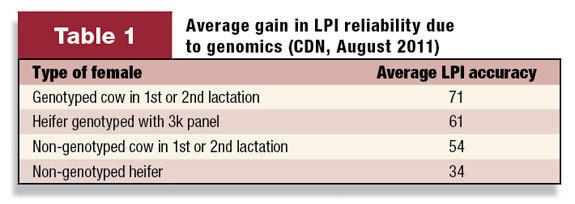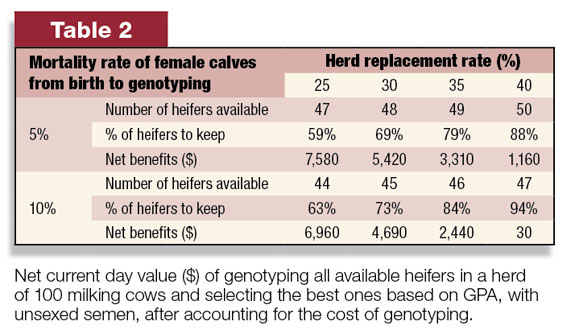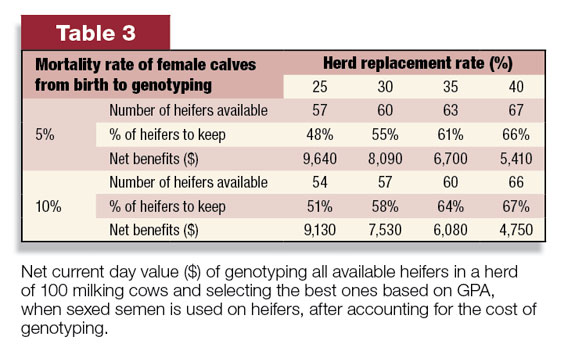Genomics offers new opportunities for female selection. Breed associations, some A.I. companies and other organizations involved in genetic testing now offer programs for the genotyping of females based on the collection of tissue samples such as hair, nasal swabs or blood. These samples are sent to accredited laboratories, which use genotyping panels to obtain a genetic profile (called a genotype) for each tested animal. The genotypes are then used by the USDA or by CDN to produce genomic evaluations.
The 50k panel, with 50,000 markers, has been used for the selection of young bulls since 2008. It can also be used for cow selection. However, because of its relatively high cost ($140), it is used primarily to evaluate elite females, such as potential bull dams and cows for embryo production.
Since September 2010, a panel with fewer markers has been available for $47 per animal. Once an animal has been tested with this panel, which now contains 6,000 markers, its 50k genotype can be reconstructed with high accuracy (generally more than 96 percent), provided some of its ancestors, particularly sires, have been 50k genotyped.
This process is called imputation from 6k to 50k. The 6k panel, therefore, makes it possible to select heifers with nearly the same accuracy as if they were genotyped with the 50k panel, but at a reduced cost.

The resulting genomic evaluation is significantly more accurate than the parent average that is otherwise available for selecting a heifer. A comparison between accuracy levels for genotyped and non-genotyped females is shown in Table 1 for the Canadian system (CDN).
It is worthwhile noting that a genotyped heifer has a more accurate genetic evaluation than a non-genotyped first-lactation cow.
Heifer genotyping is a tool producers can use according to their needs. For example, it can be used to better assess the commercial value of the top heifers or cows in the herd, or to decide which bulls to use for mating.
On the opposite end, it can be used to decide which heifers should be culled. The strategy we will discuss first consists of genotyping all heifers in the herd, preferably when they are young, and selecting the best for herd replacement based on their GPA.

The estimated net economic benefits that can be achieved through genotyping all available heifers with the 6k panel are shown in Table 2.
These benefits are expressed in current value, after accounting for the cost of genotyping, based on the herd replacement rate and the mortality rate of female calves from birth to genotyping.
Preferably, heifers should be genotyped within 2 to 3 months after birth and selected based on a minimal GPA threshold for the herd.
The shown benefits result from an increase in the performance of selected heifers, and of their daughters, over three lactations, minus genotyping costs.
The table is based on an average LPI accuracy of 62 percent for the 6k panel, a net economic value of $29 for 100 points of LPI and a genotyping cost of $47 per heifer.
In addition, we assumed a calving interval of 14 months, 30 percent of culled cows calving in the current year and an inflation rate of 5 percent to compute the current-day value of benefits.
The number of heifers kept was 10 percent above the replacement rate to account for involuntary culling on fertility and to create a “safety margin” in case of a higher-than-expected cow culling rate, an unfavourable sex ratio or an increase in herd size to adjust for new quotas.
The net benefits in Table 2 do not include any savings that would accrue by raising fewer heifers when heifer-raising costs are higher than their sale price.
These savings can be substantial in many situations, in fact higher than the benefits shown here. If, on the other hand, the expected heifer price is higher than the cost of raising them, as could occur in an elite herd that has a ready market for its heifers, the producer is better off keeping the heifers he is not using for replacement and selling them at the right opportunity.
Looking at Table 2, it is clear that economic gains depend very much on the percentage of heifers to keep for replacement, including the safety margin.
If nearly all available heifers are required, then there is little value in genotyping them, and the result is a loss corresponding to the cost of genotyping.
On the other hand, if the number of available heifers is substantially higher than the number needed, substantial economic gains are possible.
The number of available heifers depends on the replacement rate, the size of the safety margin, the calving interval and the mortality rate of female calves from birth to genotyping, and this is how it is calculated in Table 2.
Since the net economic benefits due to the genetic superiority of selected heifers depend on the number of available candidates, the use of sexed semen on heifers can greatly enhance these benefits.
One primary reason for using sexed semen on first-calf heifers is to reduce calving difficulties, both for “peace of mind” and because calving problems can have costly long-term consequences for the future productivity of heifers.

Genotyping all heifers is, then, a good way to select the top ones for replacement. With sexed semen on heifers, net economic benefits range from $5,000 to $10,000 for a herd of 100 cows, depending upon the herd replacement rate, as shown in Table 3.
This does not include any benefits from the sale of excess heifers.
A producer who uses sexed semen on heifers, genotypes the female calves early on, and is able to get $300 for each heifer calf under 3 months old that falls below an established GPA threshold, is likely coming out ahead economically.
The extra cost of sexed semen is largely compensated by savings from reduced calving problems, so it should not be counted against the above benefits.
One drawback with sexed semen is that it is not available for all bulls. However, A.I. companies are starting to market sexed semen from top-genotyped young bulls. As long as enough young bulls are used, and none overused, this is a good way to benefit from recent advances in genomics.
Tables 2 and 3 do not account for the benefits arising from the genetic superiority the selected heifers and their daughters will transmit to their future progeny.
On the other hand, they compare the selection of heifers based on their GPA to a situation with no heifer selection. The benefits would be smaller if selection on GPA was compared to a situation where the producer systematically used parent averages to select heifers.
However, the use of parent averages for this purpose has been somewhat limited, with many producers opting to use other criteria.
If a producer already uses parent averages to select his young heifers, he can combine this selection with genotyping in order to maximize profit.
If more than 90 percent of heifers are needed for replacement, including the safety margin, there is little value to be gained from genotyping, as discussed earlier.
If 85 to 90 percent of heifers are needed, the producer can sort the bottom 30 percent of heifers on PA for his selection index (ex. LPI), genotype them and cull the lowest third on their GPA.
There is only a small risk that some heifers that should be culled are not in the low PA group. This risk is not worth the cost of genotyping all heifers, so genotyping only part of the herd is the best strategy economically.
If between 70 and 85 percent of heifers are needed, the producer can genotype the bottom 50 percent of the herd based on PA and cull the worst ones for GPA. If less than 70 percent of heifers are needed, then all heifers should be genotyped.
In conclusion, benefits derived from heifer genotyping depend on the herd situation. Each producer must decide whether genotyping some or all of his heifers is worth the cost, depending on the percentage of heifers he needs for replacement.
Otherwise, genotyping can be reserved for the evaluation of top animals in the herd, for mating purposes or to better establish their market value. The use of genotyping panels by dairy producers is still in its infancy, at least in commercial herds, but is likely to increase as the concept gains acceptance and the technology keeps improving.
References omitted due to space but are available upon request. Click here to email an editor.





